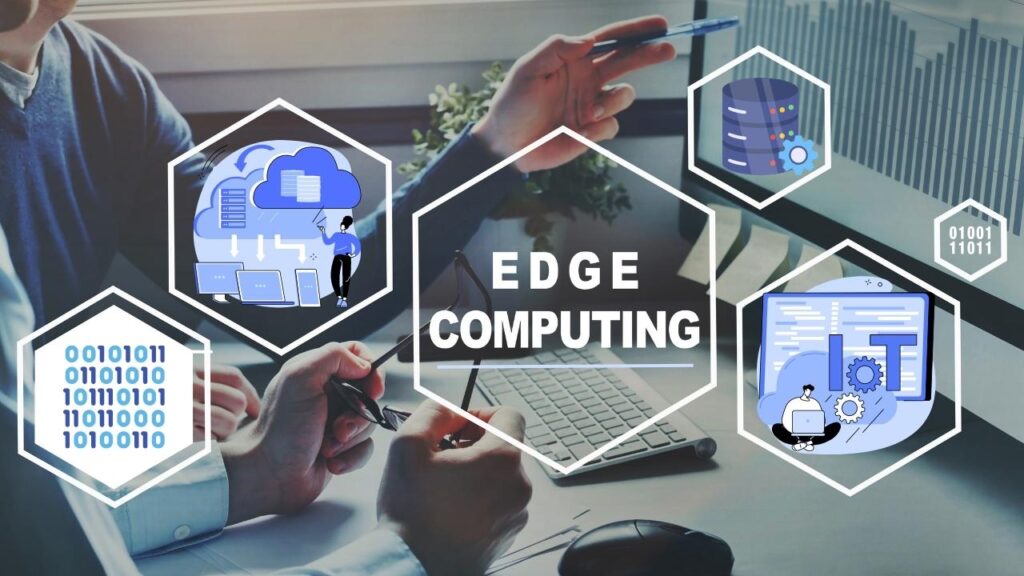Edge computing is like having a mini, high-speed computer right by your side! It’s a pretty cool, new way of working with data that’s all about bringing the processing power closer to where the action is.

Instead of having all the data trek across networks to some far-off data center, edge computing steps in and processes this data right where it’s being created.
This means it can work with more data, faster, and get you real-time results that can help make decisions on the spot.
Table of Contents
What is Edge Computing?
Edge computing is a distributed computing model that’s designed to bridge the gap between data storage and the point of necessity. In simple terms, it’s all about bringing computation and data storage right to where it’s needed.
This innovative method flips the traditional model on its head. Instead of concentrating all the computing power in one place, like in an on-site data center, edge computing spreads it out to the “edge” – that’s right at or near the user.
This setup helps businesses better manage and use their physical resources. Plus, it opens up possibilities for creating more interactive and human-like experiences.
And where is edge computing being used, you ask? Well, you’d be surprised! It’s powering self-driving cars, guiding autonomous robots, analyzing data from smart devices, and even revolutionizing the shopping experience in automated retail stores.
It’s pretty amazing, don’t you think?
Components of Edge Computing
The essence of edge computing can be summarized into three key components, each playing a vital role in the functioning of this computing model.
Edge Devices
These are the physical devices that produce data. Think of sensors, smartphones, laptops, and IoT devices. They generate a vast amount of data every second. With edge computing, these devices can process data locally or transmit it to a nearby computing resource rather than sending it to far-off data centers or clouds.
Network Edge
The network edge refers to the part of the internet that’s closest to end devices. It’s the gateway between the core network and the local networks. In edge computing, this is where most of the data processing happens, reducing the latency and improving the performance of applications.
On-premises Infrastructure
This includes the local data storage and processing facilities. They can be server rooms or data centers located on-site. Edge computing takes advantage of these facilities to process and store data close to its source. This results in a significant reduction in bandwidth usage and an improvement in application response times.
Why is Edge Computing Important?
You might be wondering, “Why all the fuss about edge computing?” Well, the answer lies in the evolving digital landscape. The current trend of digitization and the IoT revolution demands real-time processing and analysis of massive amounts of data.
Real-time Data Processing and Low Latency
The beauty of edge computing lies in its ability to decentralize data processing, pushing it to the very edge of the network, as close as possible to the source of the data. By processing data locally, edge computing significantly reduces latency, which is the time it takes for data to travel from its source to its destination. This approach facilitates real-time data processing and analytics, a feature that’s indispensable in today’s fast-paced world.
Consider applications like autonomous vehicles, industrial automation, or remote healthcare services where high-speed data processing is of the essence. In such scenarios, even a minor delay can potentially cause significant problems. For instance, a self-driving car needs to process data from its sensors in real-time to navigate effectively and safely. Similarly, in remote healthcare, swift data transmission can make a world of difference during critical moments.
Efficient Bandwidth Utilization and Network Performance
Another exciting advantage of edge computing is the way it optimizes bandwidth usage. By processing data closer to its source, it eliminates the need to transmit large volumes of data over the network, reducing the strain on bandwidth and preventing network congestion. As a result, the overall network performance and reliability see a considerable boost. Imagine having smoother streaming experiences, faster downloads, and more responsive online gaming, all thanks to edge computing!
Enhanced Data Security and Privacy
In an age where data breaches are a major concern, edge computing presents a strategic advantage. It strengthens data security and privacy by keeping sensitive data at its origin, reducing the risk associated with transmitting it over long distances. As data is processed locally on edge devices, it minimizes exposure to potential hackers and cyber threats. Additionally, it allows organizations to meet data sovereignty requirements by storing data within specific geographic boundaries.
In essence, edge computing isn’t just another technological jargon. It’s a practical, robust solution that is rapidly becoming indispensable in our increasingly interconnected world. Whether you’re a tech enthusiast, a business leader, or just someone who enjoys seamless streaming on your device, understanding the importance and applications of edge computing can enrich your digital experience and offer fresh insights into the world around you.





